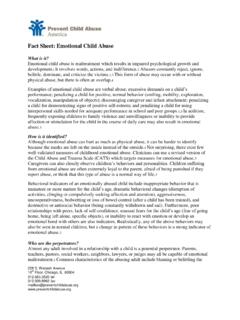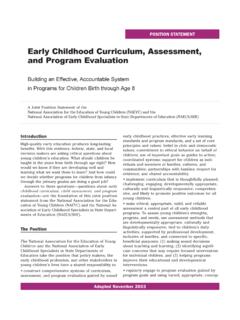Transcription of Diabetic Ketoacidosis: Evaluation and Treatment
1 March 1, 2013 Volume 87, Number 5 American Family Physician 337 Diabetic Ketoacidosis: Evaluation and TreatmentDYANNE P. WESTERBERG, DO, Cooper Medical School of Rowan University, Camden, New Jersey Diabetic ketoacidosis (DKA) con tinues to have high rates of morbidity and mortality despite advances in the Treatment of dia betes mellitus. In a study of 4,807 episodes of DKA, 14 percent occurred in persons older than 70 years, 23 percent in persons 51 to 70 years of age, 27 percent in persons 30 to 50 years of age, and 36 percent in persons younger than 30 In a second study of 28,770 persons younger than 20 years (mean age of 14 years) with diabetes, 94 percent had no episodes of DKA, 5 percent had one epi sode, and 1 percent had at least two Additionally, DKA occurred more often in females, in persons with a migration back ground, and in persons 11 to 15 years of DKA has a case fatality rate of 1 to 5 per ,4 Although the highest rate of mortality is in older adults and persons with comorbid conditions, DKA is the leading cause of death in persons younger than 24 years with diabe tes, most often because of cerebral ,4 Although persons with DKA typically have a history of diabetes, 27 to 37 percent have newly diagnosed ,6 This is especially true in young children.
2 Most per sons with DKA have type 1 diabetes. There is also a subgroup of persons with type 2 dia betes who have ketosis prone diabetes; this subgroup represents 20 to 50 percent of per sons with Persons with ketosis prone diabetes have impaired insulin secretion; however, with proper glucose management, beta cell function improves and the clinical course resembles that of type 2 These persons are often black or Latino, male, middle aged, overweight or obese, have a family history of diabetes, and have newly diagnosed results from insulin deficiency from new onset diabetes, insulin noncompli ance, prescription or illicit drug use, and increased insulin need because of infection (Ta b l e 1).
3 4,10 16 This insulin deficiency stim ulates the elevation of the counterregula tory hormones (glucagon, catecholamines, cortisol, and growth hormone). Without Diabetic ketoacidosis is characterized by a serum glucose level greater than 250 mg per dL, a pH less than , a serum bicarbonate level less than 18 mEq per L, an elevated serum ketone level, and dehydration. Insulin deficiency is the main precipitating factor. Diabetic ketoacidosis can occur in persons of all ages, with 14 percent of cases occurring in persons older than 70 years, 23 percent in persons 51 to 70 years of age, 27 percent in persons 30 to 50 years of age, and 36 percent in persons younger than 30 years. The case fatality rate is 1 to 5 percent.
4 About one-third of all cases are in persons without a history of diabetes mellitus. Common symptoms include polyuria with polydipsia (98 percent), weight loss (81 percent), fatigue (62 percent), dyspnea (57 percent), vomiting (46 percent), preceding febrile illness (40 percent), abdominal pain (32 percent), and polyphagia (23 percent). Measurement of A1C, blood urea nitro-gen, creatinine, serum glucose, electrolytes, pH, and serum ketones; complete blood count; urinalysis; electrocar-diography; and calculation of anion gap and osmolar gap can differentiate Diabetic ketoacidosis from hyperosmolar hyperglycemic state, gastroenteritis, starvation ketosis, and other metabolic syndromes, and can assist in diagnosing comorbid conditions.
5 Appropriate Treatment includes administering intravenous fluids and insulin, and monitoring glucose and electrolyte levels. Cerebral edema is a rare but severe complication that occurs predominantly in chil-dren. Physicians should recognize the signs of Diabetic ketoacidosis for prompt diagnosis, and identify early symp-toms to prevent it. Patient education should include information on how to adjust insulin during times of illness and how to monitor glucose and ketone levels, as well as information on the importance of medication compliance. (Am Fam Physician. 2013;87(5):337-346. Copyright 2013 American Academy of Family Physicians.) Patient Information: A handout on this topic is available at online at from the American Family Physician website at Copyright 2013 American Academy of Family Physicians.
6 For the private, non-commercial use of one individual user of the website. All other rights reserved. Contact for copyright questions and/or permission Ketoacidosis338 American Family Physician Volume 87, Number 5 March 1, 2013the ability to use glucose, the body needs alternative energy sources. Lipase activity increases, causing a breakdown of adipose tissue that yields free fatty acids. These com ponents are converted to acetyl coenzyme A, some of which enter the Krebs cycle for energy production; the remainder are bro ken down into ketones (acetone, acetoac etate, and hydroxybutyrate). Ketones can be used for energy, but accumulate rapidly. Glycogen and proteins are catabolized to form glucose.
7 Together, these factors pro mote hyperglycemia, which leads to an osmotic diuresis resulting in dehydration, metabolic acidosis, and a hyperosmolar state (eFigure A).DiagnosisTYPICAL CLINICAL PRESENTATIONThe presentation of DKA varies with severity and comor bid conditions. Polyuria with polydipsia is the most com mon presenting symptom and was found in 98 percent of persons in one study of childhood type 1 diabetes. Other common symptoms included weight loss (81 percent), fatigue (62 percent), dyspnea (57 percent), vomiting (46 percent), preceding febrile illness (40 percent), abdomi nal pain (32 percent), and polyphagia (23 percent).17 Dehydration causes tachycardia, poor skin turgor, dry mucous membranes, and orthostatic hypotension.
8 The metabolic acidosis may lead to compensatory deep (Kuss maul) respirations, whereas increased acetone can be sensed as a fruity smell on the patient s breath. Mental status can vary from somnolence to lethargy and coma. A detailed Evaluation may reveal precipitating factors, espe cially nonadherence to medical regimens and infection, which are common causes of DIAGNOSISA lthough hyperosmolar hyperglycemic state can be confused with DKA, ketone levels are low or absent in persons with hyperosmolar hyperglycemic state. Other causes of high anion gap metabolic acidosis, such as alco holic ketoacidosis and lactic acidosis, must be ruled out. Ta b l e 2 provides the differential diagnosis of ,18 DIAGNOSTIC TESTINGThe diagnosis of DKA (Ta b l e 3) is based on an ele vated serum glucose level (greater than 250 mg per dL [ mmol per L]), an elevated serum ketone level, a pH less than , and a serum bicarbonate level less than 18 mEq per L (18 mmol per L).
9 4 Although arterial blood gas measurement remains the most widely recommended test for determining pH, measurement of venous blood gas has gained acceptance. One review indicated that venous and arterial pH are clinically interchangeable in persons who are hemodynamically stable and without respiratory Traditionally, the severity of DKA is determined by the arterial pH, bicarbonate level, anion gap, and mental status of the patient (Ta b l e 3).4 An anion gap greater than 16 mEq per L (16 mmol per L) confirms metabolic acidosis. Although persons with DKA usually have a glucose level greater than 250 mg per dL, a few Table 1. Causes of Diabetic KetoacidosisDrugsAntipsychotic agents: clozapine (Clozaril),10 olanzapine (Zyprexa),11 risperidone (Risperdal)12 Illicit drugs (cocaine13) and alcohol4 Others: corticosteroids, glucagon, interferon,14 pentamidine,14 sympathomimetic agents,14 thiazide diuretics 4 InfectionPneumonia, sepsis, urinary tract infectionLack of insulinInsulin pump failureNonadherence to insulin Treatment plans.
10 Body image issues,15 financial problems, psychological factorsUnrecognized symptoms of new-onset diabetes mellitusOther physiologic stressorsAcromegaly,14 arterial thrombosis,14 cerebrovascular accident, Cushing disease,16 hemochromatosis,14 myocardial infarction, pancreatitis,14 pregnancy,14 psychological stress,16 shock/hypovolemia, trauma16 Information from references 4, and 10 through : KEY RECOMMENDATIONS FOR PRACTICEC linical recommendationEvidence ratingReferencesVenous pH may be measured as an alternative to arterial pH in persons with DKA who are hemodynamically stable and without respiratory ketone level should be used in the diagnosis and management of insulin can be used for Treatment of uncomplicated , 32 Bicarbonate therapy has not been shown to improve outcomes in persons with DKA, but is recommended by consensus guidelines for persons with a pH less than C33, 34 DKA = Diabetic = consistent, good-quality patient-oriented evidence; B = inconsistent or limited-quality patient-oriented evidence.












